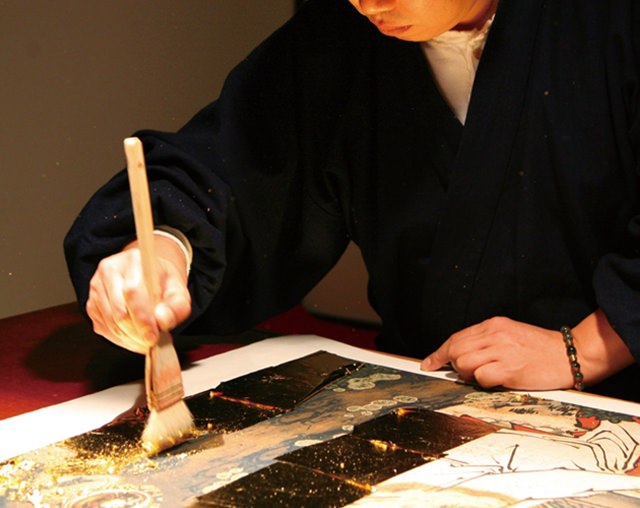News Release

Canon Inc.
Tsuzuri Project to donate high-resolution facsimile
of "Battles of Ichi-no-tani and Yashima, from 'Tales of the Heike'" residing at the British Museum to the National Center for the Promotion of Cultural Properties
TOKYO, October 23, 2018—Canon Inc. announced today that the Tsuzuri Project (officially, the Cultural Heritage Inheritance Project), a joint project organized by Canon and the Kyoto Culture Association (NPO), will donate a high-resolution facsimile of "Battles of Ichi-no-tani and Yashima, from 'Tales of the Heike'" to the National Center for the Promotion of Cultural Properties as part of the project's Stage 11. Starting today, the facsimile will be on display at the Tokyo National Museum.

Battles of Ichi-no-tani and Yashima, from 'Tales of the Heike'
Created during the early Edo period (17th to 19th centuries), the work comprises two folding screens, each of which depict one of two battles that led to the demise of the Taira Clan, also known as the "Heike." Shown on the right screen is the Battle of Ichi-no-tani (February 1184), in which the Minamoto Clan, (the "Genji"), led by Minamoto-no-Yoshitsune launched an attack on the Taira's defensive position at Fukuhara in Settsu Province (modern-day Osaka and Kobe).
The left screen depicts the subsequent Battle of Yashima (February 1185) where the Genji forces pursued the Taira, who then retreated to nearby Shidoura. The screens include such famous scenes from Tales of the Heike as Yoshitsune's raid at Hiyodorigoe and legendary archer Nasu-no-Yoichi hitting the fan target. The skilled composition and exquisite attention to detail visible on these screens suggests that they were the product of a prominent artist of the day.
As of this phase* of the Tsuzuri Project, Canon has upgraded the equipment used in the production of the facsimiles including cameras and lenses. This has made possible facsimiles with unprecedented high resolution, with this work utilizing image data with a resolution of 5400 megapixels.
The original work currently resides at the British Museum in London. With the donation of this high-resolution facsimile to the National Center for the Promotion of Cultural Properties, this renowned work of Japanese art makes a symbolic return home.
The facsimile will be on display at the Tokyo National Museum from October 23 to December 2. In addition, Visual content related to Battles of Ichi-no-tani and Yashima, from 'Tales of the Heike will be viewable on the Canon homepage and at the exhibit location starting today.
A documentary movie of the Tsuzuri Project
- *As part of Phase 11, two high-resolution facsimiles have thus far been donated: one to Tanzan Shrine in Nara Prefecture and one to the cities of Tsushima and Aisai in Aichi Prefecture.
- *In order to view videos, it is necessary to consent to the use of cookies by our website. If the videos are not displayed, please click the "Cookie Settings" and accept cookies.
Input |
Capturing high-resolution digital dataA digital SLR camera is used to capture high-image-quality data for output in the actual size and dimensions of the original cultural artifact. The camera is mounted on a specially designed turntable, enabling it to capture segmented portions of the original work, which are then digitally stitched into a single high-resolution image file. |
Color matching |
Highly accurate color matching systemThe high-resolution data is digitally processed using Canon's proprietary color matching system, which corrects for inherent differences in the lighting environment where the work was photographed. The image is printed and colors are matched on location, helping to minimize both technicians' workload and the wear on the original cultural artifact. |
Output |
World's highest level of printing technologyJapanese art expresses a dimensional depth through its delicate tonal subtleties and shading. These are recreated using Canon's imagePROGRAF large-format inkjet printer, which outputs the data onto washi or silk paper that we have specially designed to be ideally suited for printing facsimiles of the cultural artifacts and applying such finishes as gold leaf. |
Gold leaf, gold paint & isinglass |
Reproduced through time-honored and traditional techniquesAuthentic Kyoto Nishijin craftsmen reproduce the most significant features used in Japanese cultural artifacts—gold leaf, gold paint and isinglass. Special "color fading" techniques recreate the effects that time has had on the gold leaf. |
Mounting |
A discipline developed in KyotoA master Kyoto framer carefully mounts the output and finished facsimile using traditional Japanese tools. Great care is taken to recreate fading in the metalwork and fabric used in folding screens, while sliding door panels are installed exactly as they were in their original locations. |
